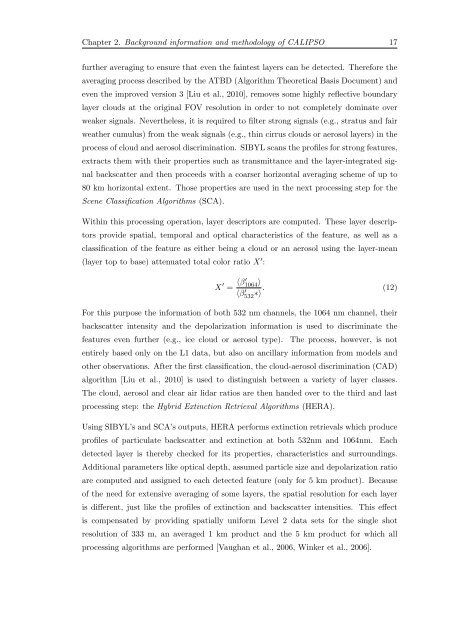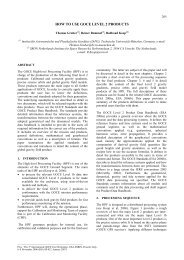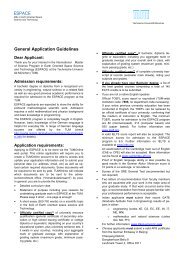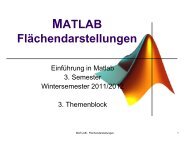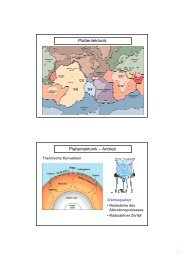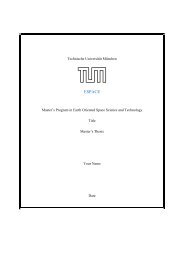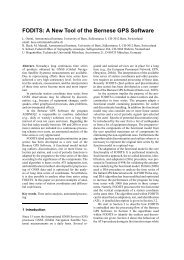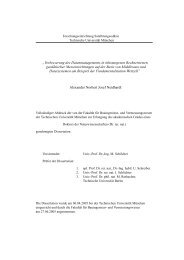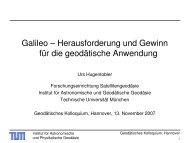Cloud Statistics from Calipso Lidar Data for the ... - espace-tum.de
Cloud Statistics from Calipso Lidar Data for the ... - espace-tum.de
Cloud Statistics from Calipso Lidar Data for the ... - espace-tum.de
You also want an ePaper? Increase the reach of your titles
YUMPU automatically turns print PDFs into web optimized ePapers that Google loves.
Chapter 2. Background in<strong>for</strong>mation and methodology of CALIPSO 17<br />
fur<strong>the</strong>r averaging to ensure that even <strong>the</strong> faintest layers can be <strong>de</strong>tected. There<strong>for</strong>e <strong>the</strong><br />
averaging process <strong>de</strong>scribed by <strong>the</strong> ATBD (Algorithm Theoretical Basis Document) and<br />
even <strong>the</strong> improved version 3 [Liu et al., 2010], removes some highly reflective boundary<br />
layer clouds at <strong>the</strong> original FOV resolution in or<strong>de</strong>r to not completely dominate over<br />
weaker signals. Never<strong>the</strong>less, it is required to filter strong signals (e.g., stratus and fair<br />
wea<strong>the</strong>r cumulus) <strong>from</strong> <strong>the</strong> weak signals (e.g., thin cirrus clouds or aerosol layers) in <strong>the</strong><br />
process of cloud and aerosol discrimination. SIBYL scans <strong>the</strong> profiles <strong>for</strong> strong features,<br />
extracts <strong>the</strong>m with <strong>the</strong>ir properties such as transmittance and <strong>the</strong> layer-integrated signal<br />
backscatter and <strong>the</strong>n proceeds with a coarser horizontal averaging scheme of up to<br />
80 km horizontal extent. Those properties are used in <strong>the</strong> next processing step <strong>for</strong> <strong>the</strong><br />
Scene Classification Algorithms (SCA).<br />
Within this processing operation, layer <strong>de</strong>scriptors are computed. These layer <strong>de</strong>scriptors<br />
provi<strong>de</strong> spatial, temporal and optical characteristics of <strong>the</strong> feature, as well as a<br />
classification of <strong>the</strong> feature as ei<strong>the</strong>r being a cloud or an aerosol using <strong>the</strong> layer-mean<br />
(layer top to base) attenuated total color ratio X ′ :<br />
X ′ = 〈β′ 1064 〉<br />
〈β 532 ′ (12)<br />
∗〉.<br />
For this purpose <strong>the</strong> in<strong>for</strong>mation of both 532 nm channels, <strong>the</strong> 1064 nm channel, <strong>the</strong>ir<br />
backscatter intensity and <strong>the</strong> <strong>de</strong>polarization in<strong>for</strong>mation is used to discriminate <strong>the</strong><br />
features even fur<strong>the</strong>r (e.g., ice cloud or aerosol type).<br />
The process, however, is not<br />
entirely based only on <strong>the</strong> L1 data, but also on ancillary in<strong>for</strong>mation <strong>from</strong> mo<strong>de</strong>ls and<br />
o<strong>the</strong>r observations. After <strong>the</strong> first classification, <strong>the</strong> cloud-aerosol discrimination (CAD)<br />
algorithm [Liu et al., 2010] is used to distinguish between a variety of layer classes.<br />
The cloud, aerosol and clear air lidar ratios are <strong>the</strong>n han<strong>de</strong>d over to <strong>the</strong> third and last<br />
processing step: <strong>the</strong> Hybrid Extinction Retrieval Algorithms (HERA).<br />
Using SIBYL’s and SCA’s outputs, HERA per<strong>for</strong>ms extinction retrievals which produce<br />
profiles of particulate backscatter and extinction at both 532nm and 1064nm.<br />
Each<br />
<strong>de</strong>tected layer is <strong>the</strong>reby checked <strong>for</strong> its properties, characteristics and surroundings.<br />
Additional parameters like optical <strong>de</strong>pth, assumed particle size and <strong>de</strong>polarization ratio<br />
are computed and assigned to each <strong>de</strong>tected feature (only <strong>for</strong> 5 km product). Because<br />
of <strong>the</strong> need <strong>for</strong> extensive averaging of some layers, <strong>the</strong> spatial resolution <strong>for</strong> each layer<br />
is different, just like <strong>the</strong> profiles of extinction and backscatter intensities. This effect<br />
is compensated by providing spatially uni<strong>for</strong>m Level 2 data sets <strong>for</strong> <strong>the</strong> single shot<br />
resolution of 333 m, an averaged 1 km product and <strong>the</strong> 5 km product <strong>for</strong> which all<br />
processing algorithms are per<strong>for</strong>med [Vaughan et al., 2006, Winker et al., 2006].


